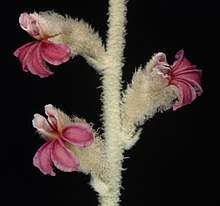Dampiera candicans
Dampiera candicans is a plant in the Goodeniaceae family, native to Western Australia[1] and the Northern Territory.[2][3]
| Dampiera candicans | |
|---|---|
 | |
| Scientific classification | |
| Kingdom: | Plantae |
| Clade: | Tracheophytes |
| Clade: | Angiosperms |
| Clade: | Eudicots |
| Clade: | Asterids |
| Order: | Asterales |
| Family: | Goodeniaceae |
| Genus: | Dampiera |
| Species: | D. candicans |
| Binomial name | |
| Dampiera candicans | |
Description
Dampiera candicans is an erect shrub growing to a height of 70 cm tall, with stems covered in brownish or greyish dense intertwined hairs. The upper surface of the leaves usually lose their covering but may have a few large coarse hairs. The lower leaf surface is always has a covering of dense intertwined hairs.The leaf lamina is 3-35 mm by 6-19 mm wide on a stalk (petiole) which is 3-10 mm long. The flowers occur in spikes which are 13-28 cm long. The sepals are about 0.1 mm long and hidden beneath hairs. The fruit is ellipsoidal to obovoid and about 2 mm long. It flowers from April to August, and is distinguished from Dampiera cinerea by its dentate leaf margins and its longer flower spikes.[3]
Distribution & habitat
It is found in north-western Western Australia and the west of the Northern Territory, growing on sandy and lateric soils.[3]
Taxonomy & etymology
It was first described by Ferdinand von Mueller in 1876.[4][5] The specific epithet, candicans, is a Latin adjective, candicans, meaning "white", "whitish" or "having white woolly hairs".[6]
References
- "Dampiera candicans". FloraBase. Western Australian Government Department of Parks and Wildlife.
- "Dampiera candicans F.Muell. | Plants of the World Online | Kew Science". Plants of the World Online. Retrieved 11 July 2020.
- Rajput, M.T,M. & Carolin, R.C. (2020). "Dampiera candicans". Flora of Australia. Canberra: Australian Biological Resources Study, Department of Agriculture, Water and the Environment. Retrieved 11 July 2020.CS1 maint: multiple names: authors list (link)
- "Dampiera candicans". Australian Plant Name Index (APNI), IBIS database. Centre for Plant Biodiversity Research, Australian Government.
- Mueller, F.J.H. von (1876). "Goodeniaceae". Fragmenta Phytographiae Australiae. 10 (85): 86.
- "candicans". www.plantillustrations.org. Retrieved 11 July 2020.